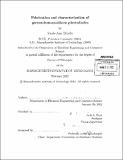Fabrication and characterization of germanium-on-silicon photodiodes
Author(s)
DiLello, Nicole Ann
DownloadFull printable version (23.87Mb)
Other Contributors
Massachusetts Institute of Technology. Dept. of Electrical Engineering and Computer Science.
Advisor
Judy L. Hoyt.
Terms of use
Metadata
Show full item recordAbstract
Germanium is becoming an increasingly popular material to use in photonic systems. Due to its strong absorption in the near infrared and its relative ease of integration on silicon, it is a promising candidate for the fabrication of CMOS-compatible photodetectors. The goal of this thesis is to understand the physics of Ge-on-Si photodiodes, especially the dark current. Low-pressure chemical vapor deposition was used to deposit thick (1 - 2 [mu]m) films on silicon substrates either selectively in oxide windows or in blanket films. Photodetectors were fabricated in both types of films and their optical and electronic properties are discussed. It was found that the main source of leakage current in these detectors is the generation of carriers at the Ge/passivation interface. This especially affects small devices, as the perimeter/area ratio is much larger than for large devices. A post-metallization anneal in nitrogen at 400°C was found to reduce the dark current of small devices (10 x 10 pm) by ~1000X at -1 V. The same anneal reduces the dark current of larger devices (100 x 100 [mu]m) by ~140X. Through metal-oxide-semiconductor capacitor and doping studies, it was found that the anneal draws holes to the surface of the germanium, leading to better isolation of the devices and reduced leakage current. It was also found that threading defects play a role in leakage current. Threading defects arise because of the 4% lattice mismatch between germanium and the underlying silicon. For 1 jim-thick germanium films, as-grown samples are expected to have -5 x 108 cm- 2 threading defects. At this level, these defects are the dominant leakage current mechanism. Annealing the films at high temperatures can reduce the defect density. Large-area (300 x 300 pm) devices fabricated with a post-metallization anneal and with a threading defect density of -2 x 107 cm-2 were found to have a dark current density of ~1 mA/cm2 and a responsivity of 0.32 A/W at -1 V and 1550 nm.
Description
Thesis (Ph. D.)--Massachusetts Institute of Technology, Dept. of Electrical Engineering and Computer Science, 2012. Cataloged from PDF version of thesis. Includes bibliographical references (p. 155-165).
Date issued
2012Department
Massachusetts Institute of Technology. Department of Electrical Engineering and Computer SciencePublisher
Massachusetts Institute of Technology
Keywords
Electrical Engineering and Computer Science.